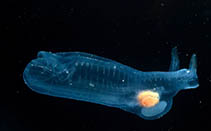Thetys vagina Tilesius, 1802
Virgin salpaWarning: DOMDocument::load(): SSL operation failed with code 1. OpenSSL Error messages: error:140770FC:SSL routines:SSL23_GET_SERVER_HELLO:unknown protocol in C:\Apache24\htdocs\includes\SpeciesSummary.lib.php on line 1236
Warning: DOMDocument::load(): Failed to enable crypto in C:\Apache24\htdocs\includes\SpeciesSummary.lib.php on line 1236
Warning: DOMDocument::load(https://sealifebase.nrm.se/webservice/AquaMaps/getAMap.php?genus=Thetys&species=vagina): failed to open stream: operation failed in C:\Apache24\htdocs\includes\SpeciesSummary.lib.php on line 1236
Warning: DOMDocument::load(): I/O warning : failed to load external entity "https://sealifebase.nrm.se/webservice/AquaMaps/getAMap.php?genus=Thetys&species=vagina" in C:\Apache24\htdocs\includes\SpeciesSummary.lib.php on line 1236
Classification / Names Common names | Synonyms | CoL | ITIS | WoRMS
| Salpida | Salpidae
Environment: milieu / climate zone / depth range / distribution range Ecología
Pelágico; rango de profundidad 0 - 150 m (Ref. 2376). Temperate
Distribución Países | Áreas FAO | Ecosistemas | Ocurrencias, apariciones | Introducciones
Indo-Pacific, Atlantic Ocean and the Mediterranean: from New Zealand to Japan, East Pacific Ocean from California to Bering Sea. Tropical to temperate.
Length at first maturity / Tamaño / Peso / Age
Maturity: Lm ? range ? - ? cm Max length : 12.0 cm TL macho / no sexado; (Ref. 1610)
Marine, planktonic; tolerates colder waters than most salps (Refs. 1134, 126266). Associated with an attached phyllosomata of the western rock lobster Panulirus cygnus, which was found to consume its host's tissue, exhibiting opportunistic feeding (Ref. 108806).
Life cycle and mating behavior Madurez | Reproducción | Puesta | Huevos | Fecundidad | Larva
Members of the order Salpida includes clonal and sexual phases in its life cycle. Life cycle: The oozooid holds in its stolon the buds and blastozooids, each containing an egg. The blastozooid becomes a brood sac for the fertilized egg which later breaks free as a young zooid.
Main reference
Referencias | Coordinador | Colaboradores
Kott, P. 2005. (Ref. 1134)
IUCN Red List Status (Ref. 130435)
CITES status (Ref. 108899)
Not Evaluated
CMS (Ref. 116361)
Not Evaluated
Threat to humans
Human uses
| FishSource |
Herramientas
Más información
Países
Áreas FAO
Ecosistemas
Ocurrencias, apariciones
Introducciones
Stocks
Ecología
Dieta
componentes alimenticios
Áreas FAO
Ecosistemas
Ocurrencias, apariciones
Introducciones
Stocks
Ecología
Dieta
componentes alimenticios
Age/Size
Crecimiento
Length-weight
Length-length
Morfología
Larva
Abundancia
Crecimiento
Length-weight
Length-length
Morfología
Larva
Abundancia
Fuentes de Internet
BHL | BOLD Systems | CISTI | DiscoverLife | FAO(Publication : search) | Fishipedia | GenBank (genome, nucleotide) | GloBI | Gomexsi | Google Books | Google Scholar | Google | PubMed | Árbol de la vida | Wikipedia (Go, búsqueda) | Expediente Zoológico
Estimates based on models
Preferred temperature
(Ref. 115969): 7.3 - 24.7, mean 14.8 (based on 2418 cells).
Price category
(Ref. 80766):
Unknown.



